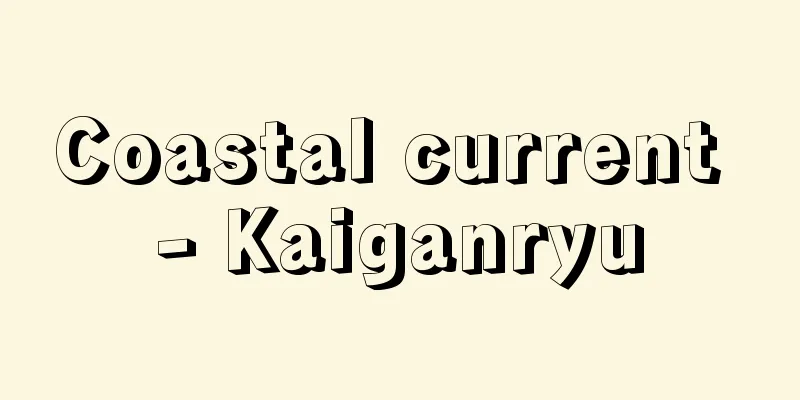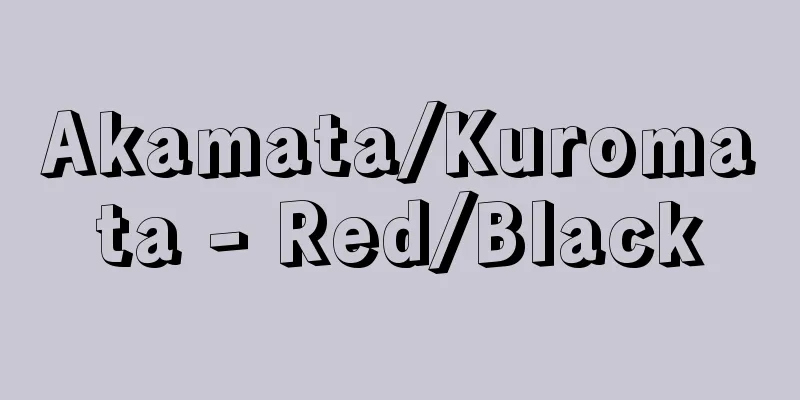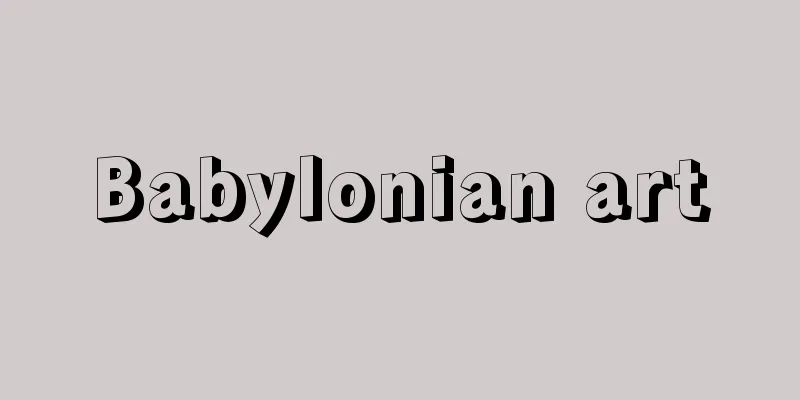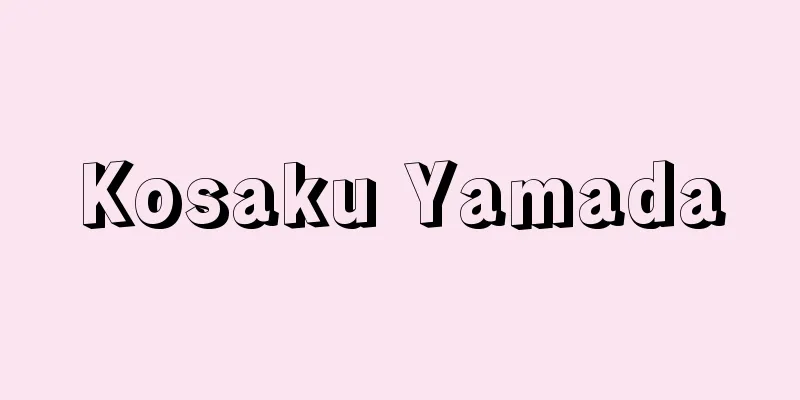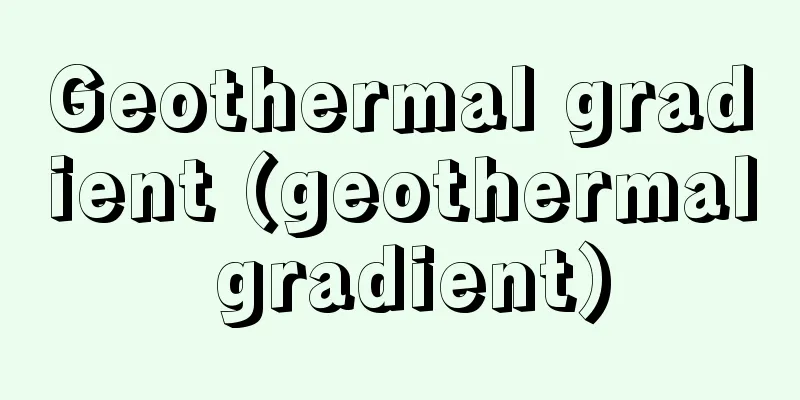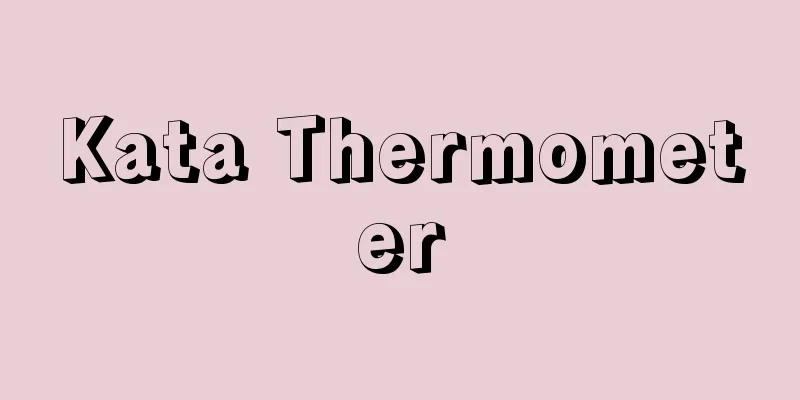Dada - Dada (English spelling)

|
An art and literary movement that developed in Europe and America during and after World War I (1914-1918). It was characterized by an anti-aesthetic and anti-moral attitude, but its character was not necessarily uniform depending on the time and place where it took place. [Taro Nomura] ZurichThe center of the movement during the war was Zurich, Switzerland, where young artists who hated the war gathered to appeal to a spirit of negation and destruction with their anger toward reality. These artists included Romanian poet Tristan Tzara, German writer and theater director Hugo Ball, fellow writer Richard Huelsenbeck (1892-1974), and artists Arp and Hans Richter. In February 1916, they opened an artists' club called Cabaret Voltaire, which had an exhibition hall and a small stage, and used it as their base to challenge all traditional values, conventional forms, and the superiority of reason, sparking demonstrations and scandals that mocked and denied these things. At that time, they randomly opened a Larousse dictionary and came across the word "Dada," which they named their movement. The Zurich Dada held avant-garde art exhibitions and published the magazine Dada, edited by Tzara, in which they pioneered a new form of poetry that utilized chance motifs, but their main aim seems to have been to delve into the Dadaist spirit of negation, which they believed to mean "nothing," and to reduce art to a blank slate. Beneath their anarchic behavior, they harbored a desire to place art on the same level as real life. [Taro Nomura] new yorkMarcel Duchamp was an artist who anticipated this desire and embodied a radical rejection of traditional beauty. In 1913, he caused a scandal with his painting Nude Descending a Staircase No. 2 at the Armory Show, an exhibition of modern European art held in New York. In 1915, he moved to New York and caused a sensation by exhibiting readymades as figurative objects. Although he did not use the name Dada, he promoted a Dada-like movement as a central figure at the gallery 291 around the same time as Zurich. This circle included Picabia and Man Ray. Their interest in familiar reality and the development of new methods and materials of expression give this circle a slightly different nuance from the Zurich Dada of destruction. Picabia joined the Zurich Dada after founding the magazine 391 in Barcelona in 1917. Dada III, which he edited with the help of Tzara, contained the Dada manifesto. [Taro Nomura] BerlinGerman Dada was started by the inspiration of Huelsenbeck, and in the Berlin circle it was strongly politically colored, reflecting the social situation after World War I. It is notable that the technique of photomontage was developed here as an expression of social participation. In particular, the work of the painter Gross, who was a scathing critic of German militarism and the reactionary capitalist class, was remarkable. Ideologically inclined towards Marxism, he energetically promoted creative activities that encouraged social change. [Taro Nomura] HanoverIn Hannover, the poet and artist Schwitters published the magazine "Merz" on his own, exuding the spirit of Dada. Inspired by Cubist papier-colle, he created anti-artistic drawings using waste from everyday life, but by chance he came across the word "merz" on a fragment of a print he had pasted onto a flat surface, and used that to name his work (merz-Bild). His aim was to free the imagination through the collection of randomly found objects and their unexpected encounters, but the materials eventually spilled out of the plane and piled up (merz-Bau). [Taro Nomura] CologneIn Cologne, Arp, Ernst, and Johannes Baargeld (1891-1927) launched the Dada movement with the magazine "Ventilator" in 1919. Ernst found clues to uncover the world of hallucinations and the unconscious in collages that combined illustrations of machines, while Arp opened up prospects for the future by producing reliefs that explored the intersection between painting and sculpture, and organic, "anonymous" objects that explored the meaning of meaninglessness. [Taro Nomura] ParisParis Dada, centered around poets such as André Breton, Paul Éluard, Louis Aragon, and Philippe Soupault from the magazine Literature (founded in 1919), became a powerful movement with the addition of Tzara, Ernst, and Picabia. Breton and Soupault created the collection of poems Les Magnets (1920) in which they wrote words automatically (automatically) for half a month in a sort of blank state (without any preconceptions), but this attempt was already a creative experiment that went beyond the Dada of destruction and negation and sought unknown realities in the realm of the unconscious. Paris Dada ended when Breton, who resonated with Freud and turned his attention to the inner world, broke away from Aragon and Éluard, who were oriented toward political reform, and eventually developed into the Surrealist movement. [Taro Nomura] Inheritance and EvolutionMany of the trends in American and European art that arose around 1960 after World War II in opposition to Abstract Expressionism were reminiscent of Dada. These include Neo-Dada, Junk Art, and Pop Art in America, and Nouveau Réalisme in Europe. Many of these trends continued and developed the materials (anti-artistic everyday items, industrial products and their waste, images provided by photography and the mass media) and techniques (collage, assemblage, photomontage) that Dada focused on. These trends of the 1960s, which responded to the new technological era and the realities of mass society, established "anti-art," which Dada initiated, as one of the fundamental concepts of 20th century art, along with "representation," "abstraction," and "fantasy." In Japan, the Neo-Dada Organizers were formed in April 1960 by Arakawa Shusaku, Shinohara Ushio (1932-), Yoshimura Masunobu (1932-2011) and others. [Taro Nomura] "Contemporary Painting 16: The Dada Movement and Painters," commentary by M. Sanouillet, translated by Takiguchi Shuzo (1973, Heibonsha)" ▽ "Dada," by K. Tautz-Smith, translated by Yagyu Fujio (1976, Parco Publishing)" ▽ "Dada: Art and Anti-Art," by H. Richter, translated by Hariu Ichiro (1987, Bijutsu Shuppansha)" ▽ "Japanese Dada," edited by Shirakawa Masao (1988, Shoshi Kaze no Bara)" ▽ "Reading Expressionism and Dada," by Hirai Masao (1996, Hakusuisha)" ▽ "For Students of Dada and Surrealism," by Hamada Akira, Tabuchi Shinya, and Kawakami Tsutomu (1998, Sekaishisosha)" ▽ "Dada and Surrealism," by M. Gale, translated by Iwaya Kunio and Tsukahara Fumi (2000, Iwanami Shoten)" ▽ "Photomontage: Manipulation and Creation - Images of Dada, Constructivism, and Surrealism" by D. Ades, translated by Kenji Iwamoto (2000, Film Art Co., Ltd.)" ▽ "The Avant-Garde of Language - Dada and Futurism in the 20th Century" by Fumito Tsukahara (Kodansha Gendai Shinsho) [References] | | | | | | | | | | |Source: Shogakukan Encyclopedia Nipponica About Encyclopedia Nipponica Information | Legend |
|
第一次世界大戦(1914~1918)中から戦後にかけて、ヨーロッパとアメリカに展開された美術および文学上の運動。反美学的、反道徳的な態度を特色とするが、運動が行われた時と場所に応じてその性格はかならずしも一様でない。 [野村太郎] チューリヒ大戦中の中心地はスイスのチューリヒで、この地に戦争を嫌って集まった若い芸術家たちは、現実への怒りを込めて否定と破壊の精神をアピールした。ルーマニア出身の詩人トリスタン・ツァラ、ドイツの作家兼演出家フーゴー・バル、同じく作家リヒャルト・ヒュルゼンベックRichard Huelsenbeck(1892―1974)、美術家アルプ、ハンス・リヒターらがそれで、彼らは1916年2月、展示場と小舞台をもつ芸術家クラブ「キャバレー・ボルテール」を開店し、ここを根城としていっさいの伝統的価値や因襲的形式や理性の優位に挑戦し、これらを愚弄(ぐろう)し否定するデモやスキャンダルを巻き起こした。その際、彼らはラルース辞典を気まぐれに開いてそこで偶然目についた単語「ダダ」を運動の名称とした。このチューリヒ・ダダは、前衛美術展を開催したり、ツァラ編集の雑誌『ダダ』を発行して、そのなかで偶然のモチーフを利用した詩の新形式を開拓したりしているが、彼らの主目的は「なにものも意味しない」ダダの否定精神をつきつめ、芸術を白紙に還元することにあったと考えられる。そのアナーキー的な身ぶりの底に、彼らは芸術を実人生と同じ地平に置こうとする欲求を秘めていたのである。 [野村太郎] ニューヨークこの欲求を先取りし、伝統美の急進的な否定を具体化した美術家はマルセル・デュシャンである。1913年、ニューヨークで催されたヨーロッパ現代美術展「アーモリー・ショー」で、絵画作品『階段を降りる裸体No.2』でスキャンダルをよんだ彼は、1915年ニューヨークに移住し、レディーメイド(既製品)をそのまま造形的オブジェとして展示することでセンセーションを巻き起こした。彼はダダの名称を用いなかったが、画廊「291」の中心的存在としてチューリヒとほぼ同時期にダダ的な運動を推進した。このサークルにはピカビア、マン・レイらがいる。身近な現実への関心や新しい表現方法と素材の開発は、このサークルがチューリヒの破壊のダダとはややニュアンスを異にする点である。ピカビアは1917年バルセロナで雑誌『391』を創刊したのち、チューリヒ・ダダと合流した。彼がツァラを助けて編集した『ダダⅢ』には、ダダの宣言文が掲載された。 [野村太郎] ベルリンドイツのダダは、ヒュルゼンベックの刺激によって始められ、ベルリンのサークルにおいては、第一次世界大戦後の社会状況を反映して強い政治色に彩られている。ここでは写真モンタージュ(フォトモンタージュ)の技法が社会参与の表現として開拓されたことが特筆される。とくにドイツ軍国主義と反動的資本家層を痛烈に批判した画家グロッスの活躍は目覚ましい。彼は思想的にマルキシズムに傾き、社会変革を鼓舞する制作活動を精力的に推進した。 [野村太郎] ハノーバーハノーバーでは、詩人でもある美術家シュビッタースがただ一人で雑誌『メルツ』を発行し、ダダの気を吐いた。彼はキュビスムのパピエ・コレにヒントを得て、日常生活の廃棄物を素材にした反芸術的な作画を行ったが、たまたま平面に貼(は)った印刷物の断片にmerzの文字があるのをみつけ、それを制作の呼び名とした(メルツ絵画merz-Bild)。偶然の拾得物の寄せ集めと、それらの意外な出会いによって想像力を解放しようとするものであるが、それらの素材はやがて平面をはみ出して堆積(たいせき)されていった(メルツ構築物merz-Bau)。 [野村太郎] ケルンケルンでは、1919年アルプ、エルンスト、バールゲルトJohannes Baargeld(1891―1927)らが、雑誌『通風機』によってダダの運動をおこした。エルンストは、機械の図版を組み合わせたコラージュ作品で幻覚や無意識の世界をあばく糸口をみつけ、アルプは、絵画と彫刻との接点をさぐるレリーフや、無意味の意味をさぐる有機的で「匿名の」オブジェ作品を制作して将来への展望を開いた。 [野村太郎] パリアンドレ・ブルトン、ポール・エリュアール、ルイ・アラゴン、フィリップ・スーポーら、雑誌『文学』(1919創刊)による詩人たちを中心とするパリのダダは、ツァラ、エルンスト、ピカビアらを迎えて強力な運動体となった。ブルトンとスーポーは、半月間自らを一種の白紙の状態(いっさいの先入観をもたない)においてオートマチックにことばを記述(自動記述)した詩集『磁場』(1920)をつくったが、この試みはすでに破壊と否定のダダを乗り越えて無意識の領域に未知の現実を探ろうとする創造的な実験であった。パリ・ダダは、フロイトに共鳴して内的世界へ目を向けたブルトンが、政治変革を志向するアラゴン、エリュアールと決別したときに終わり、やがてシュルレアリスムの運動に発展していく。 [野村太郎] 継承と展開第二次世界大戦後、抽象表現主義に対抗して1960年前後におこったアメリカおよびヨーロッパの美術の動向には、ダダを回想させるものが多い。アメリカにおけるネオ・ダダ、ジャンク・アートJunk Art(廃物芸術)、ポップ・アート、ヨーロッパにおけるヌーボー・レアリスムがそれである。これらの諸傾向は、ダダが着目した素材(反芸術的な日用品、工業製品とその廃棄物、写真およびマス・メディアが提供するイメージ)や技法(コラージュ、アッサンブラージュ、写真モンタージュ)を継承し発展させた表現も少なくない。新しい技術時代と大衆社会の現実に即応したこれら1960年代の諸傾向は、ダダが口火を切った「反芸術」を、「表現」「抽象」「幻想」と並ぶ20世紀美術の基礎概念の一つとして定着させた。なお、日本でも1960年4月、荒川修作、篠原有司男(しのはらうしお)(1932― )、吉村益信(ますのぶ)(1932―2011)らによってネオ・ダダ・オルガナイザーズが結成された。 [野村太郎] 『M・サヌイエ解説、瀧口修造訳『現代の絵画16 ダダ運動と画家たち』(1973・平凡社)』▽『K・タウツ・スミス著、柳生不二雄訳『ダダ』(1976・パルコ出版)』▽『H・リヒター著、針生一郎訳『ダダ――芸術と反芸術』(1987・美術出版社)』▽『白川昌生編『日本のダダ』(1988・書肆風の薔薇)』▽『平井正雄著『表現主義・ダダを読む』(1996・白水社)』▽『浜田明・田淵晋也・川上勉著『ダダ・シュルレアリスムを学ぶ人のために』(1998・世界思想社)』▽『M・ゲール著、巌谷国士・塚原史訳『ダダとシュルレアリスム』(2000・岩波書店)』▽『D・エイズ著、岩本憲児訳『フォトモンタージュ 操作と創造――ダダ、構成主義、シュルレアリスムの図像』(2000・フィルムアート社)』▽『塚原史著『言葉のアヴァンギャルド――ダダと未来派の20世紀』(講談社現代新書)』 [参照項目] | | | | | | | | | | | | | | | | | | | | | | | | |出典 小学館 日本大百科全書(ニッポニカ)日本大百科全書(ニッポニカ)について 情報 | 凡例 |
>>: Thassos [island] - Thassos
Recommend
Mr. Kurushima - Mr. Kurushima
In the Middle Ages, this powerful clan ruled Kuru...
Stability
When considering how the solution x ( t ) is affec...
Scupi
…It is located in the center of the Skopje Plain,...
Gentileschi, A.
…Italian painter. His real name was Orazio Lomi. ...
Horseshoe jellyfish - Kabuto jellyfish
A ctenophore of the family Helmetidae of the class...
Gerbera jamesonii (English spelling)
… [Munemin Yanagi]. … *Some of the terminology th...
Kavādh I (English spelling)
…In the middle of the 5th century, the Hephthalit...
Fishing village - Gyoson
Compared to farming villages and mountain village...
Prince Shogun - Shinnou Shogun
A prince who was appointed Seii Taishogun by the K...
ROI - Return on Investment
The ratio of how much profit can be generated rela...
Alzheimer's fibrillary tangles
...(3) Cross-linking hypothesis: Cross-linking oc...
Tenjinkimono
It is a type of Joruri and Kabuki script. It is ba...
Jakuren - Jakuren
Year of death: Around 20th July 1202 (9th August 1...
Nuclear phase - concealment
The number of chromosomes in the nucleus of a livi...
Coniogramme intermedium (English spelling)
…[Shigeyuki Mitsuda]. … *Some of the terminology ...

